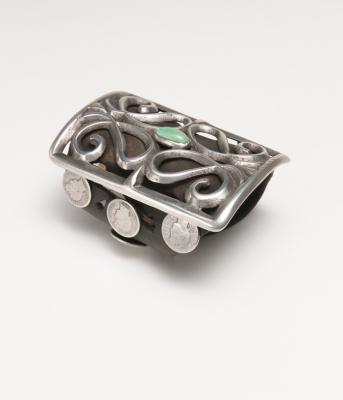Calendar of Events
Here, Now and Always: A Final Look
with Dr. Bruce Bernstein and Lillie Lane
January 26, 2020
2:00 pm through 4:00 pm

Figurine, ca. 2000
Sheila Antonio, Navajo, Gift of Yara and Gerald Pitchford
Museum of Indian Arts and Culture/Laboratory of Anthropology, 59954/12
Photography by Addison Doty
This beaded figure depicts a World War II “code talker.” Though many are familiar with the remarkable success of the Navajo code talkers in WWII, many other Native people were also instrumental in the Marine Corps’ efforts. The “code” was often the soldier’s everyday Native language, but more complex codes were also developed by Navajo and Hopi people. This figurine is miniature is size, only reaching two and a half inches tall, an example of the beader’s remarkably delicate work.

Bowguard
Bowguard, pre-1932, Artist Unknown, Navajo
Courtesy of John and Linda Comstock and the Abigail Van Vleck Charitable Trust, Museum of Indian Arts and Culture/Laboratory of Anthropology, 10061/12
Photography by Addison Doty
Navajo silverwork, with its characteristically bold design, is largely seen as emblematic of Native art in the Southwest. This bowguard was purchased for $5.00 by H. P. Mera, then-Director of the Laboratory of Anthropology, on a buying trip to the Navajo Nation in 1932. Cast silver with an open pattern of two opposing figures, the piece is centered with an oval turquoise stone. Four United States dimes, dated 1900, 1905, 1906, and 1917, anchor the sides.
